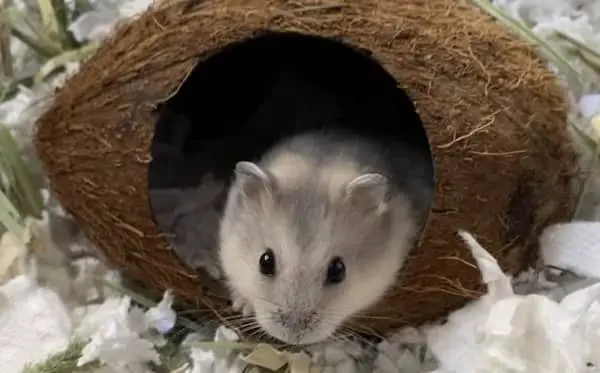Many people consider hamsters a great starter pet because of how easy they are to care for, which is true, to a point. Hamsters are still complex living, breathing creatures who sometimes do things that can confuse or worry us, such as hiding out in their house and not coming out. There is a good chance this is nothing to worry about, but it is always better safe than sorry.
So, why is my hamster not coming out of his house? Depending on how long you have had your companion, your hamster’s environment is likely to blame, though there may be other factors which could potentially pose a problem.
This article will examine how hamsters respond to change and what they need from their environment. We will also cover illness, injury, and age as driving factors behind this behavior, and briefly discuss nesting instincts.
The Winds of Change
Some animals handle change better than others, just like people. Hamsters, however, tend to handle it pretty poorly, mostly due to the fact that they are prey animals. This means that in the wild, hamsters are hunted by many species and have essentially evolved to be afraid of almost everything.
Our furry friends, both in the wild and in our homes, thrive on consistency and routine so when a big change happens, it can cause a great deal of distress for our naturally nervous pals.
If you have recently brought your hamster home from a pet store and it will not come out of its hide, it likely is still getting used to its brand-new environment which is completely normal and no cause for concern.
It just went from being housed in a small terrarium, likely with its littermates and mother, to being transported in a moving vehicle, to being dropped into a new, completely unfamiliar cage in an unfamiliar house with all-new smells, all by itself. Your new furry friend is in a kind of shock and needs a few days (at least) to take all this in and adjust to its new normal.
Slowly introduce your scent by putting an article of clothing you have recently worn near the cage. Avoid putting your hand in the enclosure for two or three days (except to give food and water), then introduce yourself by placing your hand inside with a treat on it.
Gradually increase your time in and around the enclosure until your new companion is familiar with you and your scent and knows you are a friend, not a predator.
If you have had your pocket-sized pal for a while but it recently started its new hiding behavior, think about any changes you have made that may have affected its environment. Even if it does not seem like a big deal to you, it could be causing stress for your pet and driving its behavior.
Obvious changes like moving into a new house can affect your hamster, but smaller-scale changes can easily have the same impact as well. Have you moved your furry friend into a new enclosure? Changed the kind of bedding or substrate you use?
Perhaps you have simply put its cage into another room, added or rearranged some furniture, or even brought new pets or people into your home. All these things are new and unfamiliar changes that can cause your hamster to want to hide until things are all clear.
Help your friend adjust to these changes by doing things gradually, especially if it involves a new pet. Predatory animals like cats and dogs likely will cause a great deal of stress for your hamster, so introduce them slowly and do not let the larger animals spend time in the hamster’s room alone.
If your hamster has recently taken to hiding but you have not made any recent changes to speak of, take a look at the environment itself to make sure it is conducive with a happy hammy.

Hamster Habitat
In the wild, hamsters live in dry, mostly warm climates like deserts and steppes. Further, they spend most of their time underground and are nocturnal, meaning they are mostly active at night.
When housing a hamster in your home, it is important to keep these things in mind as our tiny domestic friends are only separated from their wild cousins by a few short generations, so their needs and instincts are still quite like what they would be in the wild.
The area your pal inhabits should be dry and at least somewhat warm, with a properly sized enclosure, at least 24 inches by 12 inches, with 12 inches of height, although bigger is always better. The enclosure should be lined with plenty of paper or wood-based substrate or “bedding” for burrowing, storing food, and hiding.
If using wood shavings, only use aspen, as pine or cedar can cause respiratory issues. Additionally, the lighting should be gentle and consistent, meaning the room ideally is not one where the light is turned on and off frequently and unpredictably, and lights should not be overly bright.
Because hamsters are prey animals, their senses of hearing and smell are incredibly sharp, while their eyesight, due to living largely in the dark, is not quite as developed. This makes our furry friends quite sensitive to scent and sound, particularly ultrasound.
Ultrasound is emitted by television sets, computers, and even plumbing like dishwashers, washing machines, and pipes with running water. Ensure your companion’s enclosure is not placed too close to any of these items. Additionally, ensure your pet is housed away from barking dogs or rambunctious young children, as those sounds can cause stress as well.
During play time, children should be encouraged to use “inside voices” only with the hamster. If you have other pets in the home, specifically predatory pets like dogs or cats, ensure the other animals do not live in the same room with your hamster as their scent will cause your pocket-sized pal a good deal of stress.
Hamsters cannot help but be nervous, so they rely on us to help them feel at home. Fortunately, it is quite easy to help your companion if need be. If your hamster has taken to hiding and you have noticed one or some of these factors within its environment, consider moving it to another room with a calmer atmosphere.
If your pal lives in a calm environment and there have not been any new changes recently, perhaps your hamster is hiding due to some physical factors such as age or illness.
Injury, Illness, and the Golden Years
If your hamster has recently taken to hiding and there are no indications that its environment or changes therein are driving the behavior, it is time to rule out aging, illness, or injury as potential causes.
Unfortunately, the average lifespan of domestic hamsters tends to be between two to three and a half years, which means that by the time your furry friend reaches about 18 months, it is coming into its “golden years.”
If your friend is 18 months or older and has recently stopped other activities like running or burrowing while spending more and more time in its hide, chances are it is aging. While this is not necessarily an acute worry, it does mean that you should treasure the time you still have with your companion and help make them as comfortable as possible.
You can do this by ensuring its enclosure is all on one level for ease of mobility and making all food, water, and toys easily accessible. Your friend will thank you and you will be able to enjoy more time together.
If your hamster is still youthful but has taken to hiding recently, you will want to keep a close eye out for signs of illness or injury. Common ailments in hamsters include respiratory conditions, digestive issues, and abscesses.
Because of how small our furry friends are, simple illnesses like colds or diarrhea can swiftly become serious, so catching them early is important. Be on the lookout for signs like these:
- Decreased appetite
- Inactivity
- Huddling or hunching (in corners or hides)
- Dull, ruffled coat or hair loss
- Sneezing, wheezing, and/or discharge from nose or eyes
- Wetness around tail
- Diarrhea
- Lumps or bumps
Although this is by no means an all-inclusive list, it should give you a good idea of what to look for if your pet has been keeping out of sight and you suspect an illness. In addition to being vigilant for signs of illness, be aware of possible injuries as well.
Since hamsters are nocturnal and typically active when we are asleep, it is possible your companion injured itself while you were not awake to see it.
Examine your furry friend for cuts or scrapes, swelling, overgrown or broken teeth, and listen for popping or cracking as that may indicate a broken bone. If you notice any of these signs or the above symptoms of illness, it is best to schedule a visit to your veterinarian right away so you and your pocket-sized pal and get back to having fun.
If your healthy, happy hamster has recently been spending more time in its hide without any environmental drivers, there may be a chance some bundles of joy are on the way.
What to Expect When You’re Nesting
If your furry friend is expecting some bouncing baby hamsters in the near future (extremely near—a hamster’s gestation period is typically between 16 and 30 days, depending on the breed) nesting behavior might be one of the earliest indicators you will see.
If your hamster has been hiding out recently, check to see if they have been building up extra bedding material in their new den, as this could indicate nesting. Additionally, nesting hamsters will sometimes store food directly beneath the area they have chosen for nesting.
Keep an eye out for additional changes like rapid growth around the belly, increased water intake, and uncharacteristic aggression. If you suspect your hamster may be expecting, be sure to get to the veterinarian as soon as possible, and enjoy those tiny babies when they arrive!
Conclusion
If your hamster won’t come out of hiding, especially if it is new or if there have been recent changes in your home, it is likely due to environmental factors.
New hamsters will be hesitant and nervous until they feel at home, while veteran hamsters in your home may be experiencing some stress following changes like a move, new pet, or prolonged exposure to ultrasound.
Beyond environmental factors, your hamster may be aging, sick, or injured, so make sure to rule out any ailments or wounds and make your friend comfortable in its golden years. If none of these circumstances apply, your companion could be expecting babies, so schedule a vet visit to confirm right away.
In most cases, your hamster hiding out is not a cause for immediate concern, but it is best to eliminate the possibility of illness or injury right away. Make sure your pet is happy, healthy, and comfortable, and they will come out when they are ready.




